Abstract
Highly purified staphylococcal toxic shock syndrome toxin 1 (TSST-1) was tested for its ability to induce the cytokines tumor necrosis factor (TNF) and interleukin-1 (IL-1) from fractionated human peripheral blood mononuclear cells prepared from seven healthy donors. Highly purified monocytes alone or T lymphocytes alone did not produce TNF or IL-1 when incubated with TSST-1 at 37 degrees C for up to 72 h. However, the addition of 10 micrograms of TSST-1 per ml to a 1:1 mixture of monocytes and T cells resulted in significant TNF (predominantly TNF-alpha) and IL-1 beta production after 24 h at 37 degrees C. The nature of the monocyte/T-cell interaction did not appear to involve gamma interferon (IFN-gamma), since 10 micrograms of rabbit anti-IFN-gamma per ml did not neutralize TNF-alpha production after TSST-1 induction. Similarly, L243, a monoclonal antibody to HLA-DR which blocks TSST-1 binding to monocytes, did not inhibit TNF-alpha production following TSST-1 induction. However, direct contact between monocytes and T cells was required, since physical separation of cells in double-chamber culture wells abolished TNF-alpha secretion after TSST-1 stimulation. Furthermore, paraformaldehyde fixation of either monocytes or T cells prior to addition to viable T cells or monocytes, respectively, also abolished TNF-alpha secretion, suggesting that aside from cell contact, soluble factors were also involved. Our results suggest that cytokine production involves more than binding of TSST-1 to its receptor on monocytes alone and that cell contact with T cells and the release of a soluble factor(s) other than IFN-gamma may be essential for the induction of cytokines by this toxin.
Full text
PDF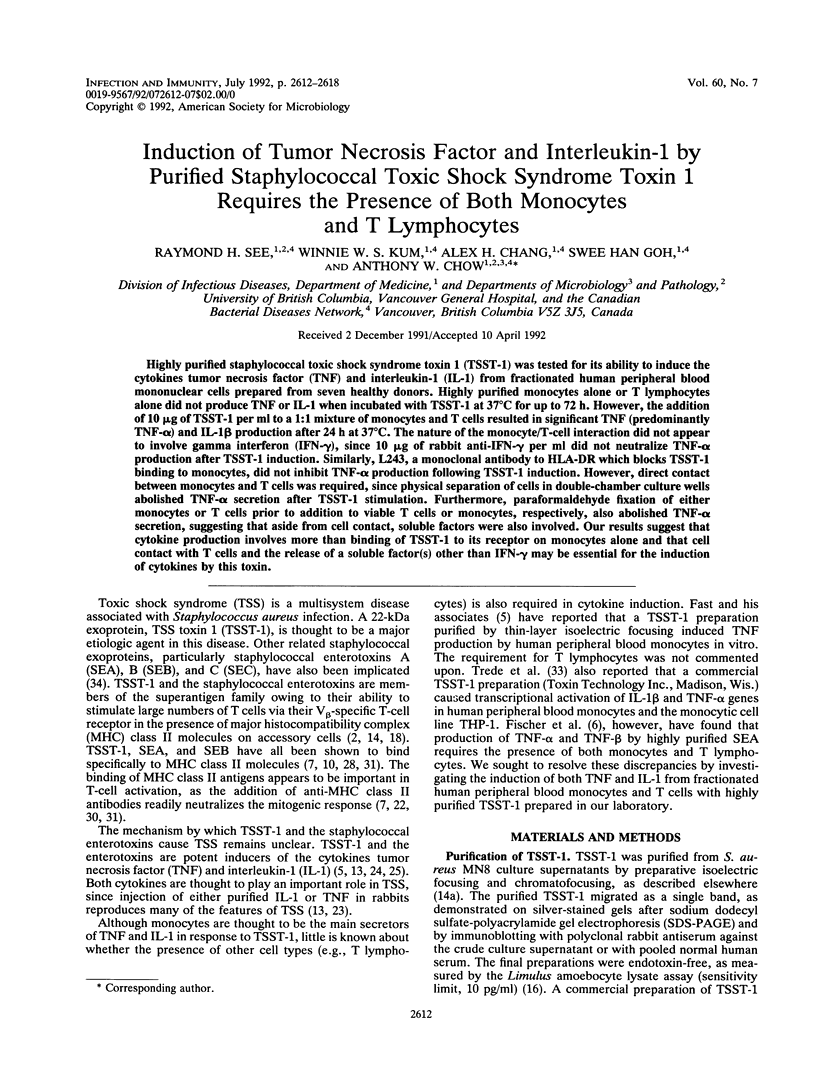
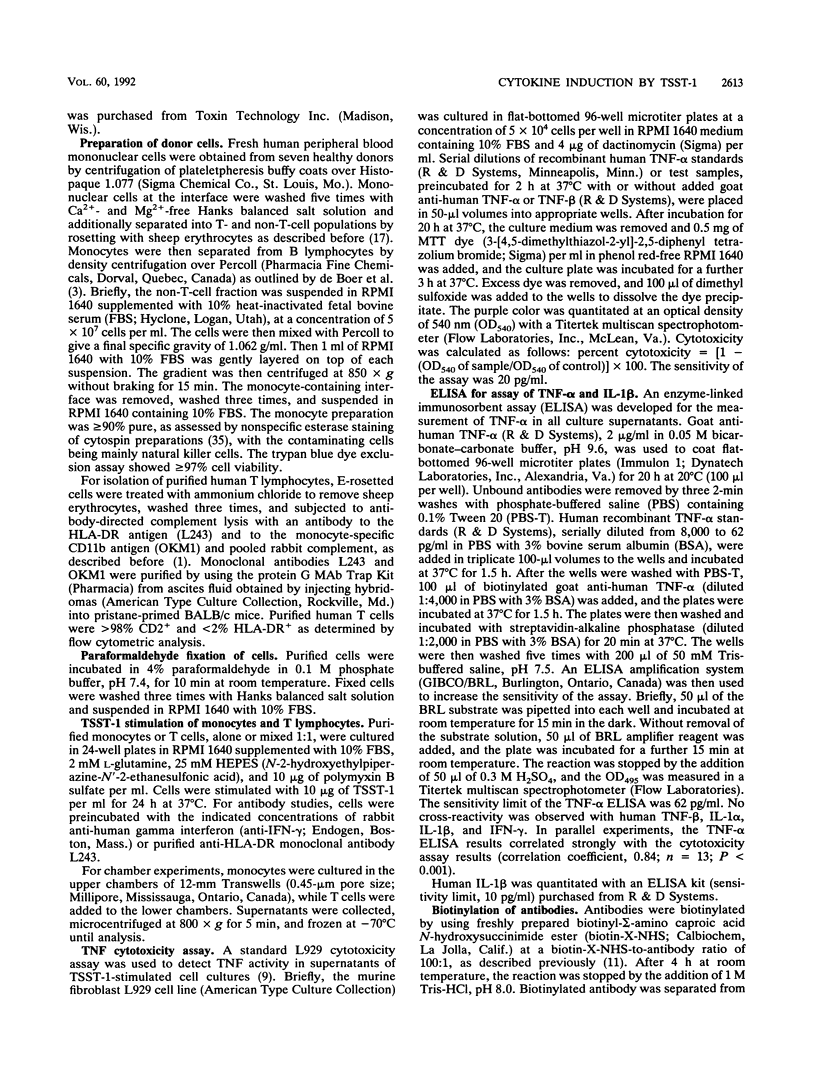
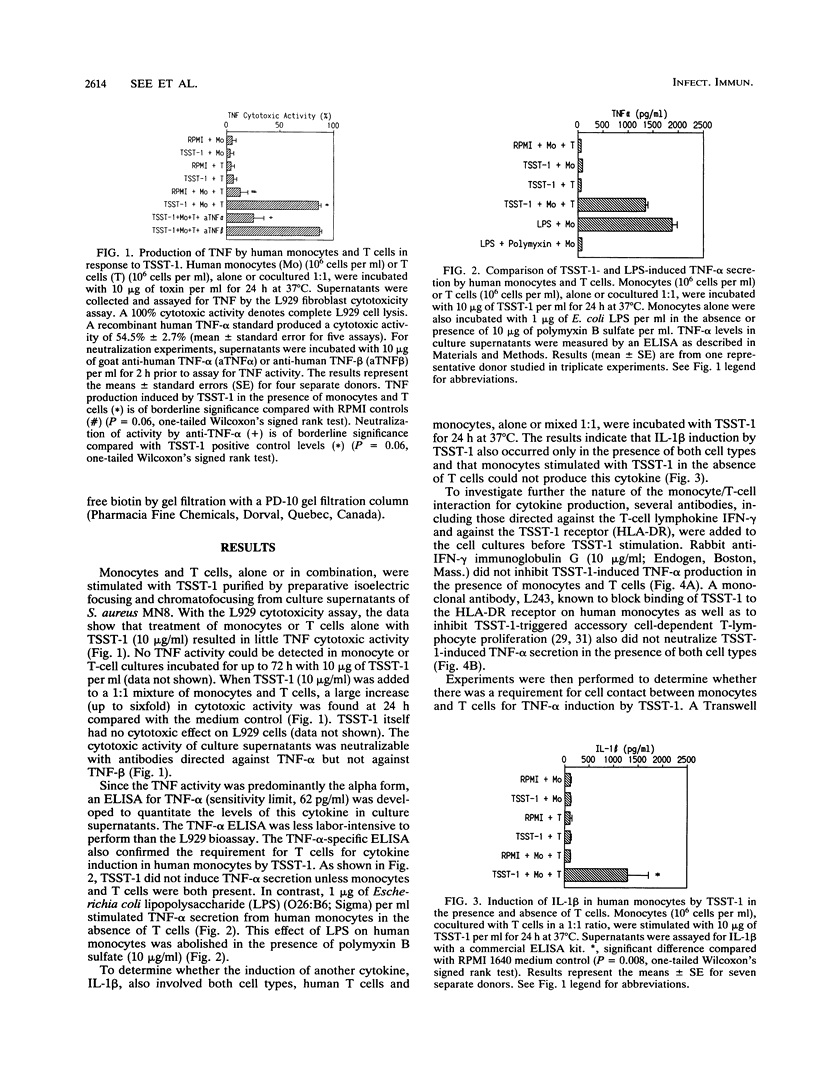
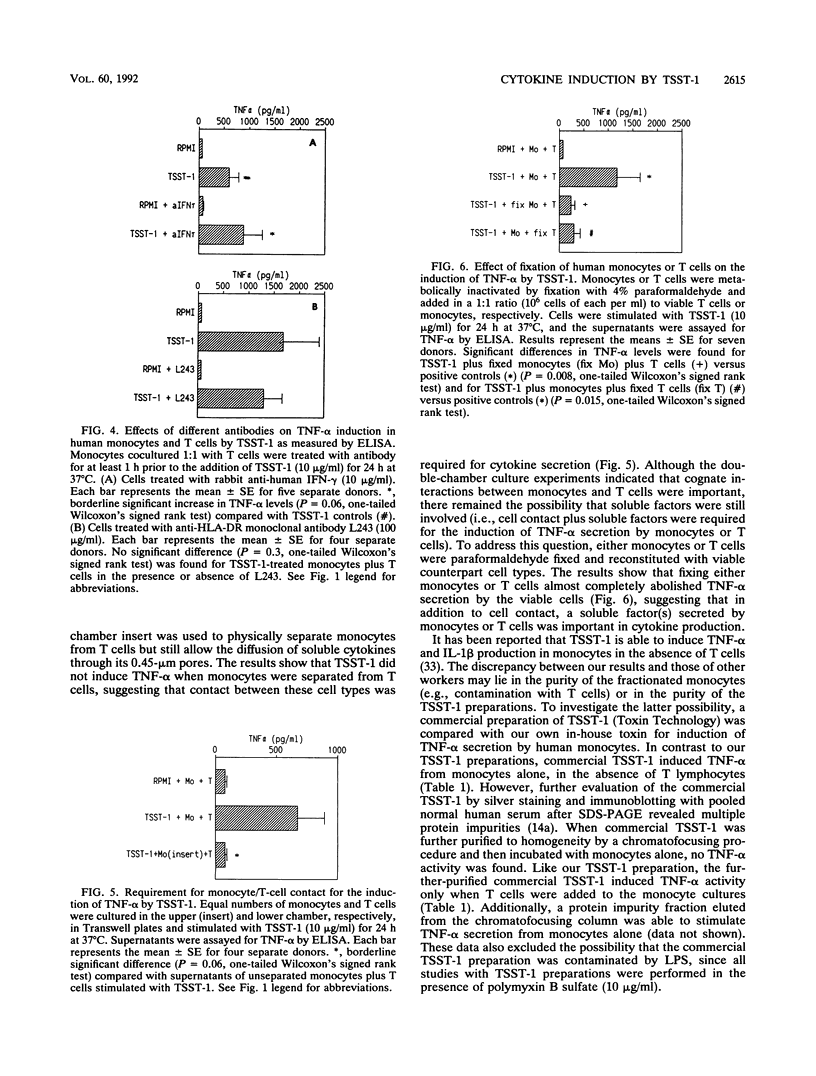
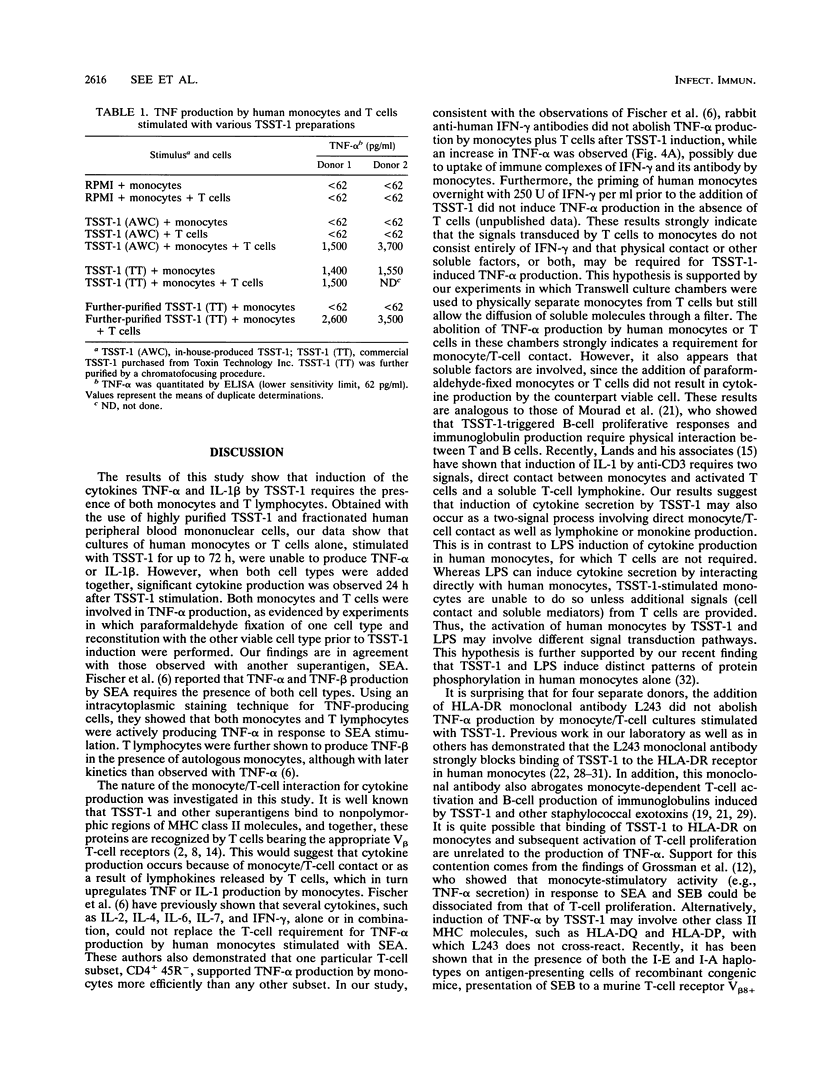
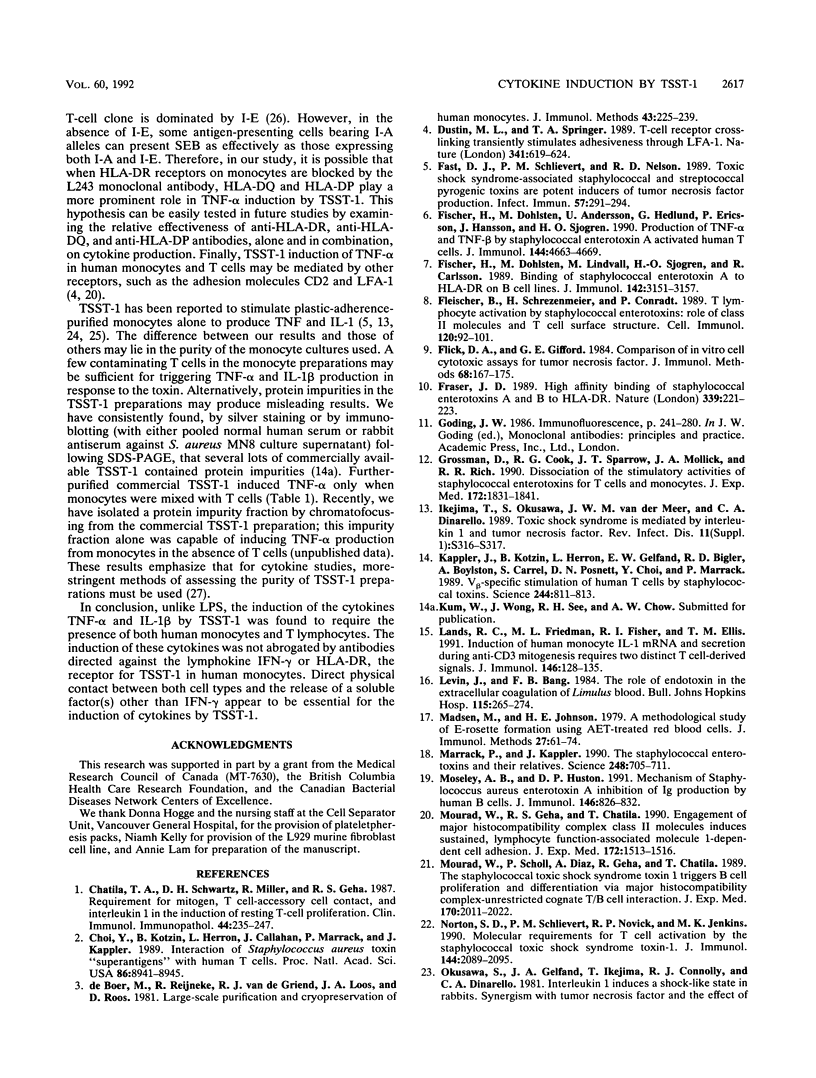
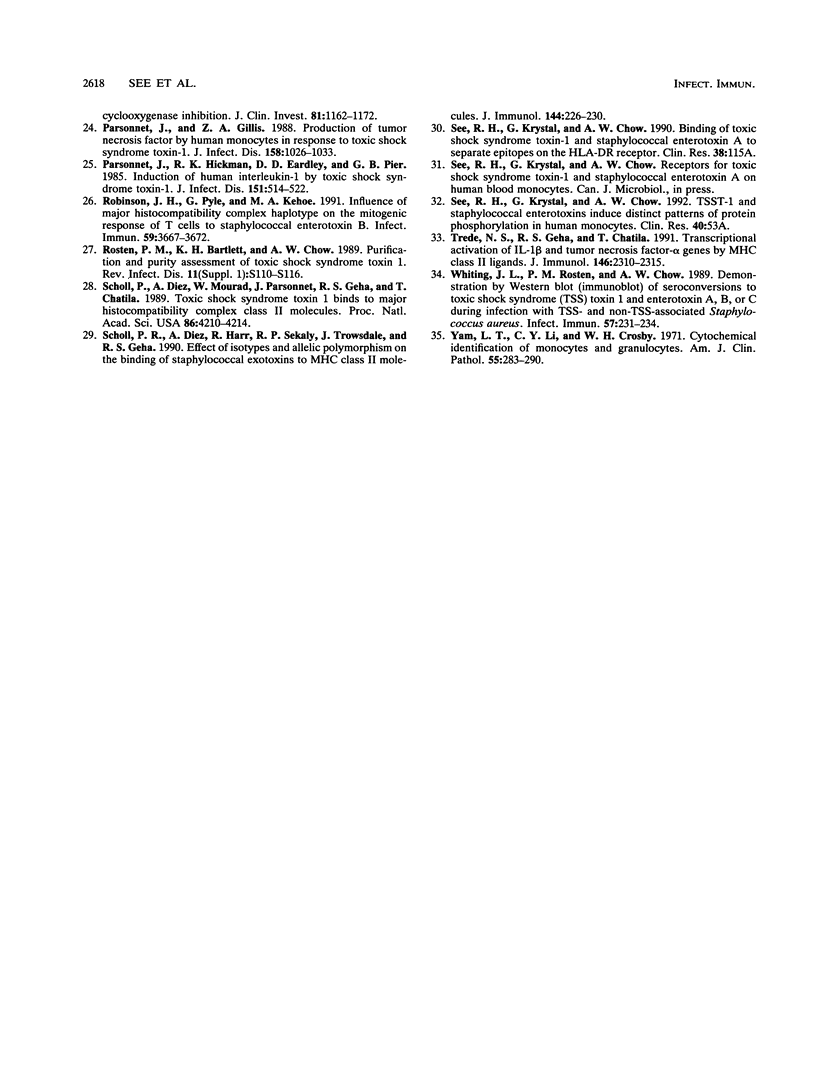
Selected References
These references are in PubMed. This may not be the complete list of references from this article.
- Chatila T. A., Schwartz D. H., Miller R., Geha R. S. Requirement for mitogen, T cell-accessory cell contact, and interleukin 1 in the induction of resting T-cell proliferation. Clin Immunol Immunopathol. 1987 Aug;44(2):235–247. doi: 10.1016/0090-1229(87)90068-7. [DOI] [PubMed] [Google Scholar]
- Choi Y. W., Kotzin B., Herron L., Callahan J., Marrack P., Kappler J. Interaction of Staphylococcus aureus toxin "superantigens" with human T cells. Proc Natl Acad Sci U S A. 1989 Nov;86(22):8941–8945. doi: 10.1073/pnas.86.22.8941. [DOI] [PMC free article] [PubMed] [Google Scholar]
- De Boer M., Reijneke R., Van de Griend R. J., Loos J. A., Roos D. Large-scale purification and cryopreservation of human monocytes. J Immunol Methods. 1981;43(2):225–239. doi: 10.1016/0022-1759(81)90027-2. [DOI] [PubMed] [Google Scholar]
- Dustin M. L., Springer T. A. T-cell receptor cross-linking transiently stimulates adhesiveness through LFA-1. Nature. 1989 Oct 19;341(6243):619–624. doi: 10.1038/341619a0. [DOI] [PubMed] [Google Scholar]
- Fast D. J., Schlievert P. M., Nelson R. D. Toxic shock syndrome-associated staphylococcal and streptococcal pyrogenic toxins are potent inducers of tumor necrosis factor production. Infect Immun. 1989 Jan;57(1):291–294. doi: 10.1128/iai.57.1.291-294.1989. [DOI] [PMC free article] [PubMed] [Google Scholar]
- Fischer H., Dohlsten M., Andersson U., Hedlund G., Ericsson P., Hansson J., Sjögren H. O. Production of TNF-alpha and TNF-beta by staphylococcal enterotoxin A activated human T cells. J Immunol. 1990 Jun 15;144(12):4663–4669. [PubMed] [Google Scholar]
- Fischer H., Dohlsten M., Lindvall M., Sjögren H. O., Carlsson R. Binding of staphylococcal enterotoxin A to HLA-DR on B cell lines. J Immunol. 1989 May 1;142(9):3151–3157. [PubMed] [Google Scholar]
- Fleischer B., Schrezenmeier H., Conradt P. T lymphocyte activation by staphylococcal enterotoxins: role of class II molecules and T cell surface structures. Cell Immunol. 1989 Apr 15;120(1):92–101. doi: 10.1016/0008-8749(89)90177-9. [DOI] [PubMed] [Google Scholar]
- Flick D. A., Gifford G. E. Comparison of in vitro cell cytotoxic assays for tumor necrosis factor. J Immunol Methods. 1984 Mar 30;68(1-2):167–175. doi: 10.1016/0022-1759(84)90147-9. [DOI] [PubMed] [Google Scholar]
- Fraser J. D. High-affinity binding of staphylococcal enterotoxins A and B to HLA-DR. Nature. 1989 May 18;339(6221):221–223. doi: 10.1038/339221a0. [DOI] [PubMed] [Google Scholar]
- Grossman D., Cook R. G., Sparrow J. T., Mollick J. A., Rich R. R. Dissociation of the stimulatory activities of staphylococcal enterotoxins for T cells and monocytes. J Exp Med. 1990 Dec 1;172(6):1831–1841. doi: 10.1084/jem.172.6.1831. [DOI] [PMC free article] [PubMed] [Google Scholar]
- Kappler J., Kotzin B., Herron L., Gelfand E. W., Bigler R. D., Boylston A., Carrel S., Posnett D. N., Choi Y., Marrack P. V beta-specific stimulation of human T cells by staphylococcal toxins. Science. 1989 May 19;244(4906):811–813. doi: 10.1126/science.2524876. [DOI] [PubMed] [Google Scholar]
- LEVIN J., BANG F. B. THE ROLE OF ENDOTOXIN IN THE EXTRACELLULAR COAGULATION OF LIMULUS BLOOD. Bull Johns Hopkins Hosp. 1964 Sep;115:265–274. [PubMed] [Google Scholar]
- Landis R. C., Friedman M. L., Fisher R. I., Ellis T. M. Induction of human monocyte IL-1 mRNA and secretion during anti-CD3 mitogenesis requires two distinct T cell-derived signals. J Immunol. 1991 Jan 1;146(1):128–135. [PubMed] [Google Scholar]
- Madsen M., Johnsen H. E. A methodological study of E-rosette formation using AET-treated sheep red blood cells. J Immunol Methods. 1979 May 10;27(1):61–74. doi: 10.1016/0022-1759(79)90239-4. [DOI] [PubMed] [Google Scholar]
- Marrack P., Kappler J. The staphylococcal enterotoxins and their relatives. Science. 1990 May 11;248(4956):705–711. doi: 10.1126/science.2185544. [DOI] [PubMed] [Google Scholar]
- Moseley A. B., Huston D. P. Mechanism of Staphylococcus aureus exotoxin A inhibition of Ig production by human B cells. J Immunol. 1991 Feb 1;146(3):826–832. [PubMed] [Google Scholar]
- Mourad W., Geha R. S., Chatila T. Engagement of major histocompatibility complex class II molecules induces sustained, lymphocyte function-associated molecule 1-dependent cell adhesion. J Exp Med. 1990 Nov 1;172(5):1513–1516. doi: 10.1084/jem.172.5.1513. [DOI] [PMC free article] [PubMed] [Google Scholar]
- Mourad W., Scholl P., Diaz A., Geha R., Chatila T. The staphylococcal toxic shock syndrome toxin 1 triggers B cell proliferation and differentiation via major histocompatibility complex-unrestricted cognate T/B cell interaction. J Exp Med. 1989 Dec 1;170(6):2011–2022. doi: 10.1084/jem.170.6.2011. [DOI] [PMC free article] [PubMed] [Google Scholar]
- Norton S. D., Schlievert P. M., Novick R. P., Jenkins M. K. Molecular requirements for T cell activation by the staphylococcal toxic shock syndrome toxin-1. J Immunol. 1990 Mar 15;144(6):2089–2095. [PubMed] [Google Scholar]
- Parsonnet J., Gillis Z. A. Production of tumor necrosis factor by human monocytes in response to toxic-shock-syndrome toxin-1. J Infect Dis. 1988 Nov;158(5):1026–1033. doi: 10.1093/infdis/158.5.1026. [DOI] [PubMed] [Google Scholar]
- Parsonnet J., Hickman R. K., Eardley D. D., Pier G. B. Induction of human interleukin-1 by toxic-shock-syndrome toxin-1. J Infect Dis. 1985 Mar;151(3):514–522. doi: 10.1093/infdis/151.3.514. [DOI] [PubMed] [Google Scholar]
- Robinson J. H., Pyle G., Kehoe M. A. Influence of major histocompatibility complex haplotype on the mitogenic response of T cells to staphylococcal enterotoxin B. Infect Immun. 1991 Oct;59(10):3667–3672. doi: 10.1128/iai.59.10.3667-3672.1991. [DOI] [PMC free article] [PubMed] [Google Scholar]
- Rosten P. M., Bartlett K. H., Chow A. W. Purification and purity assessment of toxic shock syndrome toxin 1. Rev Infect Dis. 1989 Jan-Feb;11 (Suppl 1):S110–S116. doi: 10.1093/clinids/11.supplement_1.s110. [DOI] [PubMed] [Google Scholar]
- Scholl P. R., Diez A., Karr R., Sekaly R. P., Trowsdale J., Geha R. S. Effect of isotypes and allelic polymorphism on the binding of staphylococcal exotoxins to MHC class II molecules. J Immunol. 1990 Jan 1;144(1):226–230. [PubMed] [Google Scholar]
- Scholl P., Diez A., Mourad W., Parsonnet J., Geha R. S., Chatila T. Toxic shock syndrome toxin 1 binds to major histocompatibility complex class II molecules. Proc Natl Acad Sci U S A. 1989 Jun;86(11):4210–4214. doi: 10.1073/pnas.86.11.4210. [DOI] [PMC free article] [PubMed] [Google Scholar]
- Trede N. S., Geha R. S., Chatila T. Transcriptional activation of IL-1 beta and tumor necrosis factor-alpha genes by MHC class II ligands. J Immunol. 1991 Apr 1;146(7):2310–2315. [PubMed] [Google Scholar]
- Whiting J. L., Rosten P. M., Chow A. W. Determination by western blot (immunoblot) of seroconversions to toxic shock syndrome (TSS) toxin 1 and enterotoxin A, B, or C during infection with TSS- and non-TSS-associated Staphylococcus aureus. Infect Immun. 1989 Jan;57(1):231–234. doi: 10.1128/iai.57.1.231-234.1989. [DOI] [PMC free article] [PubMed] [Google Scholar]
- Yam L. T., Li C. Y., Crosby W. H. Cytochemical identification of monocytes and granulocytes. Am J Clin Pathol. 1971 Mar;55(3):283–290. doi: 10.1093/ajcp/55.3.283. [DOI] [PubMed] [Google Scholar]


